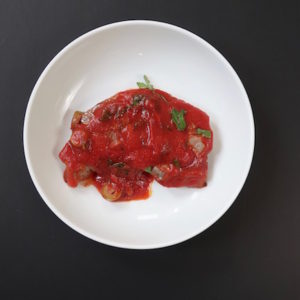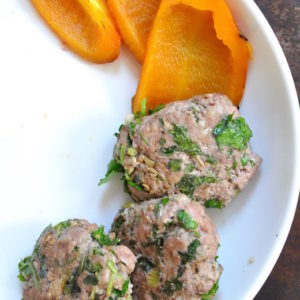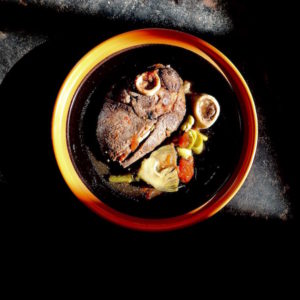Lamb Chops with Sumac

Should your fingers do this–that is, roll inward and sometimes lock–you’ll be forced to stop whatever you’re doing, put down/let go of whatever you might be holding, and unlock the offending finger(s) with your free hand.
As you might imagine, this isn’t always a realistic proposition. One cannot stop whatever she’s doing whilst tooling down Interstate 80. Or while hefting a a 350 degree Staub braiser filled with lamb stew from the oven.
You get my drift.

Meet my new oval-8 ringsplints. Not do these literally give me a grip, with any luck, they’ll slow the inevitable arthritis already making itself known in my left hand.
(I’ve taken the liberty of adding some unrelated photography here. Do you really want to see me voluntarily dislocate my fingers? I thought not.)

Oval-8s are custom made. After meeting with a hand therapist, I placed an order with a specialty firm in Charlottesville, Virginia. Despite being deemed medically necessary, ringsplints are not covered by insurance.
Cost: $87 apiece.

(Edible flowers from Thailand.)
I bought the right hand set first. I have two left finger splints, made by a kind jeweler. As the left hand splints weren’t fitted by a therapist, they’re a bit too large. They slide off when my hands get wet, so I can’t wear them while cooking or showering. But they’re better than nothing, which is why I bought the right hand set first.

Wearing correctly fitted ringsplints is like putting on Italian loafers after a lifetime of wearing cheap sneakers. At first you don’t know what to do with yourself. You stare at your feet a lot, realizing you’ve been walking kinda funny all these years. Surely everyone else is noticing your shoes as much as you are.
(People do notice ringsplints. I receive a lot of compliments on my unique jewelry.)
Then you have to run for the bus. Or go out in the rain.
You forget your shoes.
They become a part of you.
That’s what ringsplints are like.

—
Sumac is a recent arrival in my kitchen, brought here by Naomi Duguid’s award-winning Taste Of Persia. As Duguid explains in Taste Of Persia, sumac comes from “the drupes of a bush in the Rhus family.” A pretty brick red, sumac is sour, though not puckeringly so. It’s delicious on fish, poultry, lamb, or vegetables–anywhere you might use lemon or preserved lemon. Fans of lemony flavors will adore it.

Let’s talk about the lamb chops. Left to my own devices, I am not a finesse-type cook. You won’t find me delicately wrapping morsels of this or that. A search of my cupboards will not turn up plastic squeezy bottles with which to dot or drizzle.
Admittedly, this is due to inherent clumsiness. Even before carpal tunnel wrecked whatever manual dexterity I possessed, there wasn’t much manual dexterity to wreck. It’s also due to lack of a dishwasher–a recipe calling for dotting, dipping, and drizzling is a recipe calling for too damned much washing up. But most of all, I lack the patience for such cooking.

Notice I am not even discussing baking–I mean, I can bake now. Just don’t ask me to decorate what I’ve baked. I baked, okay?
All to say, I prepare these lamb chops without a thought to the spices, which are added to the lamb after it’s in the pan. There’s no worrying about eveness or whether or not spices are gonna fall into the pan juices. Some will. And that oily, crunchy goodness will get mopped up with flatbread or poured over some waiting, fragrant starch–orzo or Israeli couscous.
This is weeknight cooking, people. And it is good.

But when I made the chops for this post, I began to fret. Would there be protests from the blogosphere?
John got home from work hungry and tired. Lamb was duly served. He scarfed his portion, then asked how I’d made it.
“Do the spices bother you?” I asked. “Are they intrusive or something?”
“No, no. I like it. What’s that lemony taste?”

Thus reassured, I recalled what I like about this dish–apart from it’s being so very delicious. It’s fast.
Lamb chops being speedy, they afford you time to throw together some side dishes. This being No-Rouz, or Persian New Year, may I suggest an herb platter, more accurately known as sabzi khordan?

According to Naomi Duguid, sabzi khordan translates to “eating greens.” An herb platter is just what it sounds like–a platter of fresh herbs, as simple or elaborate as you wish it to be. Consider including fresh cheeses like feta or farmers cheese, some radishes, scallions, Arab pickles, tomatoes, and a few flatbreads.

EDS affects my digestion, giving me difficulty with raw vegetables. Yet sabzi khordan doesn’t bother me at all. Herbs are known to help digestion, after all. Perhaps nibbling throughout a meal, rather than eating a salad all at once, also helps. Whatever the case, it’s a lovely way to eat that I’ve made a happy habit.

I also threw together a version of Duguid’s Cucumber And Tomato Salad with Pomegranate Molasses:

This asks for Persian cucumbers, Roma tomatoes, fresh herbs, salt, and pomegranate molasses. Cherry tomatoes stepped in for Romas. In terms of amounts, I used far less than the original recipe–four Persian cucumbers, about two ounces cherry tomatoes, four ounces total fresh parsley and mint, a teaspoon Maldon salt, and about three teaspoons pomegranate molasses. Taste as you go. Easy, fast, delicious, good for you.

All of the above cries out for excellent flatbread. I would love to say I baked some. I would be lying to you. I (cough) ate tortillas with this. Are we still friends? Would you be happier if I lied to you?
There’s nice recipe for flatbread here.
Somewhere along the line–possibly from reading Yotam Ottolenghi’s work–I fell into the habit of mixing up small bowls of yogurt for myself. I’ll squeeze in lemon, add minced garlic, sometimes scallion, hot pepper, cumin, fresh herbs, whatever spices fit the meal. John loathes yogurt, or did until, a recent bout of tummy trouble was soothed by a few spoonfuls. I can’t say he’s a total convert to yogurt at table, but I am.

In all, a fast, easy, healthy meal, inspired by the bright flavors and beautiful colors of Persian cuisine.

Lamb with sumac
serves: 2, easily scaled upward
preparation time: about ten minutes
2 lamb shoulder chops (it’s hard to specify size; how big was the lamb? ours were about 3/4 pound each)
2 teaspoons Maldon salt OR 1 teaspoon fine sea salt
1 teaspoon ground cumin
1 teaspoon ground coriander
1 teaspoon ground fennel
1 teaspoon black pepper
1 teaspoon sumac
1 garlic clove, smashed, peeled, and minced
about 2 tablespoons olive oil (enough to coat the bottom of your pan)
about two tablespoons white wine or Vermouth
If possible, presalt the lamb chops 1-24 hours ahead of time, using 1 teaspoon fine sea salt/ or 2 teaspoons coarse sea salt per pound meat. Salt the chops on both sides, place in a baking pan, cover with foil, and refrigerate.
Bring lamb to room temperature before cooking.
Crush spices in mortar and pestle or spice grinder if they aren’t pre-ground.
Place a 12-14 inch sauté pan over medium heat. Add the olive oil and white wine or Vermouth; you want the liquid to cover the pan bottom but not swamp the lamb chops.
Add the lamb chops. Add the seasonings, including the salt, if you have not presalted the lamb (if you did presalt, don’t add more) and sumac. Cook for about 4 minutes. Some of the spices won’t stick. That’s okay–this isn’t a fancy dish.
At the four minute mark, turn the chops and cook about 4 minutes more, or until done to your liking. We like our lamb on the rare side. If you prefer it well-done, cook a bit longer.
Serve with an herb plate, flatbreads, yogurt, and the cucumber, tomato, and pomegranate molasses salad mentioned above. Or simply serve sliced cucumber and tomato on a plate. This would also be nice with Israeli couscous or orzo.
Persian rice dishes are some of the world’s finest; see Naomi Duguid’s Taste Of Persia or with Jeffrey Alford, Seductions of Rice, for recipes.
The lamb will keep, well wrapped, up the four days in the refrigerator. Freeze up the three months.
Notes: You can reduce or increase the amount of spices, of course.
I buy spices whole and grind them as needed using a mortar and pestle.
Our lamb comes from Niman Ranch; the better your lamb, the better the dish.
Shoulder is a bony cut, but the flavor makes it well worth the hassle of negotiating all those bones.





